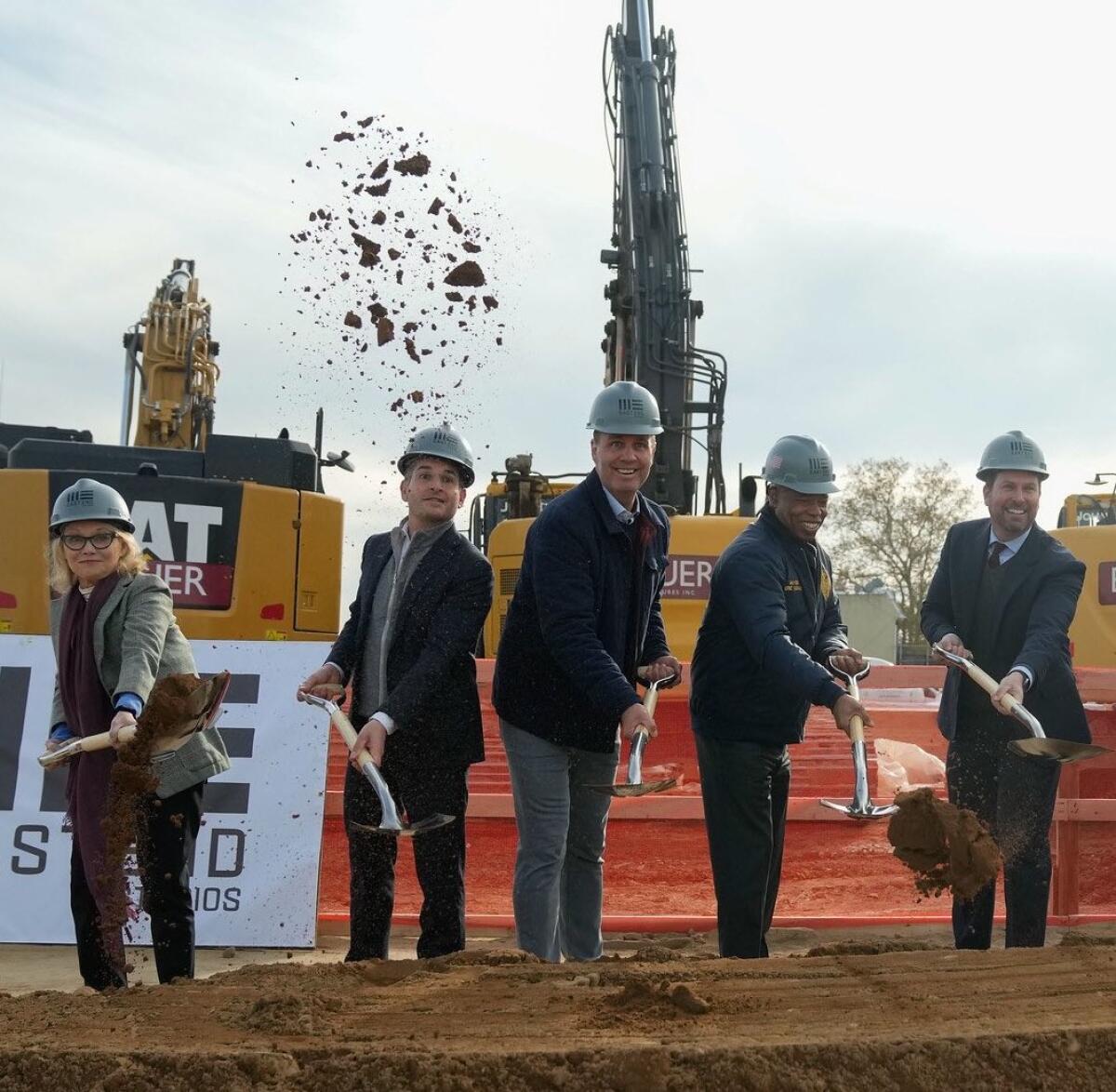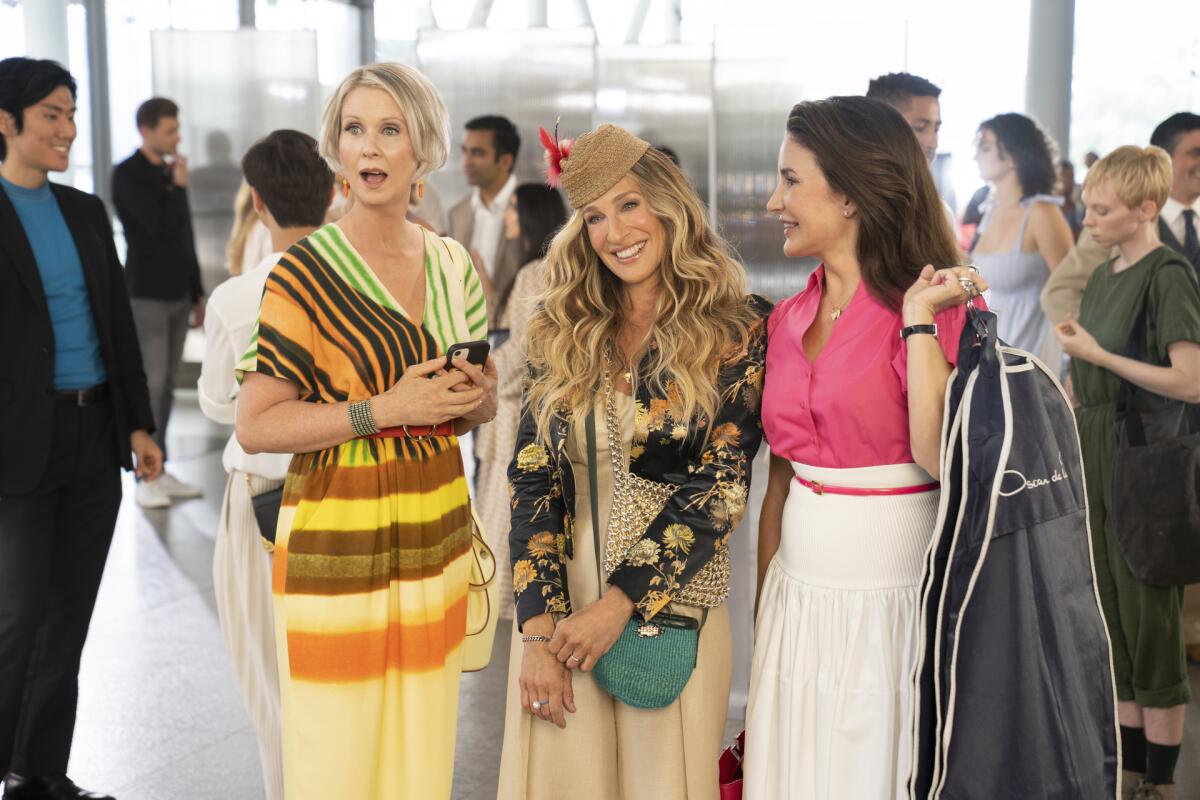Pat Swinney Kaufman may have enough ceremonial shovels in her office to start her own small construction firm.
As commissioner of the New York City Mayor’s Office of Media and Entertainment, based above the Ed Sullivan Theater in Manhattan, Kaufman helped break ground on a number of new studios and soundstages to accommodate the TV and movie producers shooting in the region.
Next year, Sunset Pier 94 Studios will open on the West Side of Manhattan, adding six state-of-the-art soundstages blocks away from Midtown and the Theater District. In Queens, a new facility called Wildflower, backed in part by Robert De Niro, will add 91,000 square feet of stage space. And East End Studios, which has four soundstage facilities in California, is scheduled to open a new space in Sunnyside, Queens, in 2025.
“We are the creative and artistic capital of this country and we are very committed to building on that,” Kaufman said. “We want it to flourish.”
The aggressive studio expansions signal New York’s continued determination to double down on the film business and compete with its main rival, Los Angeles, for a bigger slice of the Hollywood pie — even as the industry is struggling to rebound nationwide.
Last year, the New York state legislature boosted the annual film tax credit allocation to $700 million, up from $420 million. It also raised the credit on qualified expenses (including actors’ salaries) to 30% (with an extra 10% for upstate productions) and accelerated the timeline for claiming credits — a big issue for producers.
The changes were intended to help the state better compete with other states such as neighboring New Jersey, which also is adding studio space and pulling work away from New York.
New York’s film industry grew rapidly after the state enacted its first credit in 2004. Production jobs grew at an average rate of 3% annually over the next 15 years — outpacing New York City’s overall job growth in that time and adding about 35,000 jobs, according to the mayor’s office.
But the dual strikes of the writers and actors last year brought production to a standstill at a time when the region was still recovering from the pandemic.
As in Los Angeles, work has been slow to return since the new labor deals were signed in the fall, creating some jitters in an industry that accounts for 6.5% of New York’s economy.

New York Mayor’s Office of Media and Entertainment Commissioner Pat Swinney Kaufman, left, and others break ground at East End Studios in Sunnyside, N.Y.
(New York Mayor’s Office of Media and Entertainment)
In a sign of the slowdown, Brooklyn-based Broadway Stages, which has been in operation since 1983, was at 50% capacity in April, the lowest level in memory according to its communications director, Barbara Leatherwood.
“Before the pandemic, everybody was just packed,” said Leatherwood in a recent interview. “We were packed. We were at 95%.”
And more studio space is coming online. Great Point Studios, which also has locations in Atlanta, Buffalo and New Jersey, recently completed a facility in Yonkers, located 15 miles north of Midtown Manhattan.
Kaufman acknowledged that production work isn’t back to to the level it was before the strikes. “We’re watching with bated breath,” she said.
She pointed out that the number of permits to shoot in New York has grown steadily since the Writers Guild of America strike ended last September. The commissioner’s office counted 212 projects shooting in the city during April, up from 187 for the same month in 2023.
Still, the additional new studio space comes at a time when there is concern that television and movie production is at an inflection point in the streaming age.
While broadcast and cable TV series once provided a reliable number of episodes each season, from 13 to 22, season orders from streamers typically are shorter. One long-running New York-based hit, CBS’ “Blue Bloods,” will end this year after 14 seasons. Broadcast networks that once stocked up on such shows now rely more on reality competitions, game shows and live sports to fill their schedules.
As media companies such as Paramount Global and Warner Bros. Discovery face headwinds, further consolidation seems likely. After a spending spree on content in recent years, media executives are talking about making fewer films and shows in an effort to reduce costs and improve profitability.
Amid the industry challenges, some veteran soundstage owners question whether there will be enough production for the new studio space to thrive long-term.
Doug Steiner, who opened Steiner Studios at the Brooklyn Navy Yard in 1999 and recently broke ground on a 15-acre location in the Sunset Park neighborhood in Brooklyn, believes some of the newcomers will face challenges. Steiner’s soundstages provided homes for Amazon’s hit “The Marvelous Mrs. Maisel” as well as movies including “The Joker.”
“There is an explosion of proposed new studios both nationally and globally,” Steiner said. “People who have never done it have no idea what they are getting into, and it’ll be a disaster for most of them.”
The new studio entrants say their expansion is based on an increased demand for larger spaces that can handle the more elaborate and expensive productions.
“What we saw in in 2019 is an acute shortage of modern infrastructure for how films are made today,” said Robert Halmi, founder of Great Point Studios. “The shows that are being made for the streamers are much bigger than the shows that were being made for broadcast television 10 years ago.”
Andrew Kimball, president of the New York City Economic Development Corporation, believes employment levels in the film and television business will be back to pre-pandemic levels within six months; the city pegs that figure at 185,000 jobs.
“The forms of content creation are evolving as technology changes,” Kimball said. “Having the talent and stages is absolutely fundamental to the industry, and we remain very bullish even with the changes.”
The corporation partnered with Vornado Realty Trust, Hudson Pacific Properties and Blackstone to develop Sunset Pier 94 Studios, the first facility built in Manhattan specifically for film and TV production. The site, with six soundstages totaling 85,000 square feet, is set to open next year.
Halmi and others attribute the slow recovery to uncertainty surrounding the Alliance of Motion Pictures and Television Production’s talks with the International Alliance of Theatrical Stage Employees, which represents film and TV crew members. Some productions have decided to set up in Canada, rather than risk a holdup from another possible job action.
“I think we’re just in a place where the industry is right-sizing itself,” Leatherwood said. “The thirst for good entertainment that we produce in the United States has not gone away.”
One factor that soundstage owners believe they have in their favor is the support of New York City Mayor Eric Adams and Gov. Kathy Hochul, who backed the 66% increase in the state tax credit last year even as some critics have questioned its effectiveness.
“The New York credit is completely competitive in all respects,” Steiner said.
Production stages are at the core of the state’s tax credit. While Hollywood-based film and TV studios own their lots, most of the New York production spaces are independently owned businesses. If a production wants to benefit from the tax credit, it must use one of the stages recognized by the state.
“You don’t get the incentive if you come here and spend three weeks shooting outside,” said Kaufman, who helped develop the first tax credit when she was executive director of the state’s film office. “You must shoot in one of our soundstages. In our opinion this is how we build an industry.”
It took decades for New York to establish itself as the largest production hub outside of Los Angeles. While feature filmmakers always sought out New York when needed for a backdrop, attracting cost-conscious TV series wasn’t easy.
New York City was a mecca for TV during the industry’s golden age of the 1950s. Playwrights and theater-trained acting talent were based in the city and provided a steady flow of talent for live original plays, which made up much of prime-time programming in those early years.
Once Hollywood became involved in TV, production headed west. Studios such as Warner Bros. and Universal had expansive lots and crews with experience on feature films, providing the scale and convenience needed for TV to grow.
Filmed TV series dwindled in New York in the 1960s and ’70s, as the city and its residents were not always cooperative. The streets became more unruly and crime-ridden.
ABC’s gritty late-1960s cop series “N.Y.P.D.” used members of the Hell’s Angels motorcycle gang to provide security around its East Village studio space. Producers found that doing business in Los Angeles was simply more trouble-free.
As New York’s economy rebounded in the 1980s and ’90s, TV production started to trickle back in. More stars and filmmakers with roots on the East Coast wanted to work near home, which has remained the key reason for filming in the city. (When inveterate New York actor Tony Randall did the NBC sitcom “Love, Sidney” in the early 1980s, his contract guaranteed the show would be produced in the city.)
Newsletter
Subscriber Exclusive Alert
If you’re an L.A. Times subscriber, you can sign up to get alerts about early or entirely exclusive content.
You may occasionally receive promotional content from the Los Angeles Times.
“(Filming in New York) will always be a bottom-line decision,” Steiner said. “But there is some very sought-after talent that lives here and that will only work on a project if it’s here.”
Producer Dick Wolf is the trailblazer for the current New York production scene. He was insistent about making New York his base for “Law & Order” when it launched in 1990.
Wolf even negotiated his own deal with craft unions so he could keep “Law & Order” in the city when under pressure from NBC to cut the show’s budget in the early 1990s.
When HBO became a major producer of original series in the late ’90s, the premium cable channel generated New York-based hits such as “Sex and the City” and “The Sopranos.” The shows became cultural touchstones that enhanced the city’s image as a place to film. (“And Just Like That…,” the “Sex and the City” sequel on Max, now shoots in New York.)

Cynthia Nixon, left, Sarah Jessica Parker and Kristin Davis in “And Just Like That…,” the “Sex and the City” sequel on Max that shoots in New York City.
(Craig Blankenhorn / HBO Max)
But the enactment of the state’s film production tax credit in 2004 was the true catalyst for production growth. The credit was designed to allay the economic impact of the Sept. 11, 2001, terrorist attack on New York, which jolted the entire city’s economy and led to a slump in the number of motion picture and video production jobs.
Prolific producers who set up shop in New York tend to stay put. Wolf’s three “Law & Order” shows and three FBI-themed series for CBS are in production at Broadway Stages.
Robert and Michelle King made their long-running CBS hit “The Good Wife” and its sequel “The Good Fight” in New York. Their newest series, “Elsbeth,” the quirky police-legal drama recently renewed by CBS, is New York-based, as is the fourth and final season of the Kings’ Paramount+ horror series, “Evil.”
The city wants to remove any barriers to production coming in. It has a free “Made in NY” training program for production assistants, which has seen more than 1,200 participants since its inception.
“We’re working hard to stay ahead of the game and make sure we’ve got enough workforce here,” Kaufman said.




